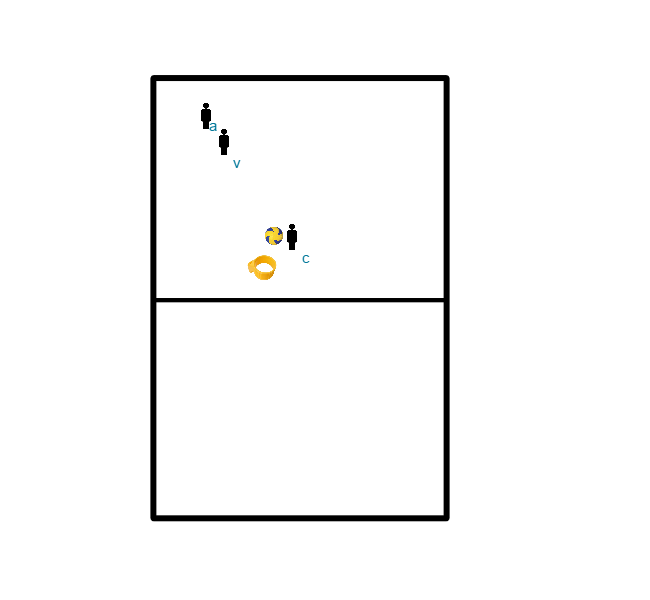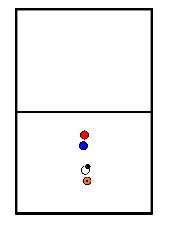Korfball drills
- divide the group into groups of 5 (it's also possible to have a different number, but adjust if necessary).
- make a box, for example 8/8 or 10/10 or 12/12.
- Of each group of 5, 1 person is a catcher, the others are the field players (if you have more than one group, you can put the catcher(s) of one group into the other group).
- The catcher tags 1 or 1½ minute and you count how many tags have been made (one player can't loose and stays in the game).
- The catchers that start tagging (recognizable because of the jacket / ribbon) and
- distribute the other remaining children per group in the box with a ball. They pass over the ball and walk free.
- The catchers try to tag someone who doesn't have the ball, so someone who has the ball is not allowed to be tagged.
- The player approached by the catcher must get the ball as quickly as possible.
- 1 attacker
- 1 defender
- 1 passer
- the duel lasts 1 minute (good for endurance!)
- In any case, the defender won't let a ball through, the shot will be allowed.
- A little pressure on the shot is necessary.
- You make a box, with an attacker in it,
- the attacker must keep moving in the box, while a defender is following.
- The other player is standing outside the box.
- The attacker starts with the ball in his/her hands and throws it to someone on the side and the person on the side throws it back to the attacker and then throws it back to someone else standing on the side.
- The defender tries to take the ball.
- When the defender takes the ball, he throws it back you will try again
- The attacker always tries to run free and the defender tries to intercept the ball
- make 2 groups
- the attack takes the ball from the trainers.
- When the defence has intercepted the ball, they return it to the trainers.
- When they have scored, the team gets a bonus and is allowed to take the ball back.
- 1 of the young trainers can act as referee to gain experience
2 children stand near a post. 1 attacker and 1 defender.
- The attacker may move around the post, towards the post and away from the post.
- The defender always stays with his back to the post and follows the defender.
- At a given moment, the attacker is given the ball by the trainer. The defender must then move directly towards the attacker and raise his hands.
In short: practicing various shooting variations in a fun competition form.
Organization: per group a post and a ball, the posts are preferably (but not necessary) arranged in a circle or rectangle. The number of people per group is less important (but all groups are about the same size).
- The first task for the groups is to score 10 goals.
- When you have completed this assignment, the person who scored the last goal runs to the trainer to pick up the next assignment.
- Which group completed all the assignments first?
- In the meantime, the trainer walks around encouraging or correcting where necessary.
- He has a piece of paper with him with a row of assignments on it. When someone gets to get the next assignment, first ask which one has just been completed (this can vary quite a bit over time) and then give the next assignment.
- An example list: 5 walk-through balls, 5 penalty throws, 5 4-meter shots, 5 walk-through balls from behind the post, 5 shots behind the post.
- 3 men per post.
- Player A starts as attacker for the post.
- Player V starts as defender at 1.5 arm's length from the shooter.
- Player C starts with the ball as catcher/feeder.
- Attacker A must try to score in a 1 to 1 duel.
- It doesn't matter how (distance, dodge, dlb).
- The job of defender V is to follow the attacker continuously at 1.5 arm's length.
- If the attacker has the ball in his hands, the defender must close.
- The defender must not tap or block the balls.
- The V must show that he or she is near the attacker but must allow the shot.
- This can be done by the defender placing her hand just above the attacker's shoulder.
- Switch positions after 1 minute .

- Group of 3 by a post
- 1 defender, 1 passer and 1 attacker
- the attacker must score as much as possible in 30 seconds
- the defender must ensure that this happens as little as possible

- Two players stand 7 meters in front of the post and eight meters apart.
- A player with the ball under the post and a receiver slightly behind the post.
- One player in front of the post takes the through-ball that is passed, after the other player in front of the post has received the ball.
- The ball is caught by the receiver.
- A1 becomes A2,
- A2 becomes A3,
- A3 becomes A4 and
- A4 becomes A1.
What can you see?
- The passer learns that the shooter can only take a through-ball if the throwing is calmly prepared, is thrown in front of the shooter and the ball is passed at the right height.
- The speed and trajectory of the shooter can be regulated by the speed of throwing, ball trajectory and ball speed.
- Learning to control problems such as timing requires a lot of repetition and sometimes adjustment of the distances used.
- The problems for the shooter, the starting position of the ball is different because the body is twisted for ball reception, lead to impure actions. Stay attentive to this.
- The action speed must be increased.
Variant: - Just like exercise 12, but the passer throws the ball to a shooter who dodges to a position diagonally behind the post.
- There is a ball through the centre where the passer must consider two opponents, his direct opponent and the shooter's opponent, as they are not far from the ball line.
Variant: - The marksman makes a feint shot and passes the ball to the player below the post indicating a through-ball.
Create a box with an attacker inside.
- The attacker has to keep moving in the box while a defender is running.
- Someone always plays the ball.
- The defender looks at the ball and tries to catch it
- Every time the attacker catches the ball, someone enters the box.
- When the defender picks up the ball, he throws it back and tries again
- The ball is thrown in a circle.
- A child starts behind the person standing next to the person with the ball.
- The ball must be overtaken.
- The rest has to make sure that the ball is thrown over.
- You put up four poles in a square,
- in the middle of the four poles you put down a pilon.
- four children will be passers at the poles and
- the rest of the children will stand by the pilon in the middle.
- First, you can choose that the attackers have to take through-balls at the poles.
- It doesn't matter which pole, they may run at the same pole a maximum of 2 times in a row.
- You can choose this, so they have to run a lot.
- The children also have to score twice, the person who does this first may definitely switch positions with a passer, the other may switch as well as soon as they score twice.
- After that you can choose to let the children do free balls, penalty throws, dodge-balls, etc.








